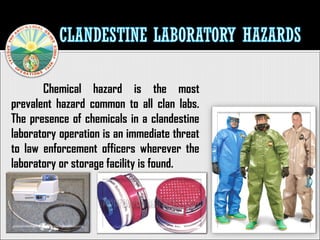1. clandestine laboratory investigation
- 1. By: PSUPT LEONARDO R SUAN (DSC) Chief, Special Operations Unit 2 - AIDSOTF
- 2. AAny facility used for the illegal manufacture of any dangerous drug and/or controlled precursor & essential chemical.
- 3. Many clandestine laboratory operators use the drug they manufacture and may be extremely paranoid. Handguns and assault rifles are weapons of choice for them.
- 4. The operating team should be well protected from dangers of toxic chemicals and must approach all clandestine laboratory situations with the assumption that there are booby traps in the sites. There are different types of these devices.
- 5. Chemical hazard is the most prevalent hazard common to all clan labs. The presence of chemicals in a clandestine laboratory operation is an immediate threat to law enforcement officers wherever the laboratory or storage facility is found.
- 6. Fire/Explosion hazard may happen with the presence of incompatible flammable chemicals at the clandestine laboratory site. Sometimes fire and explosion are the reasons for the discovery of clandestine laboratories or storage facilities.
- 7. Guidelines on Investigation All operations involving clandestine laboratories and storage facilities shall be coordinated with PNP AIDSOTF for technical assistance, proper assessment and evaluation prior to any negation operation
- 8. Guidelines on Investigation The investigation shall commence with an intelligence data gathering process to verify the existence of the clandestine laboratory or storage facility and to identify the persons involved (usually foreigners) in its operations. The intelligence operations shall be appropriately documented by reports supported by sketches, maps, photographs and other relevant pieces of evidence.
- 9. Guidelines on Investigation Under no circumstance shall any person deliberately use his or her sense of smell, taste, or touch to identify suspected dangerous drugs, chemicals or hazardous materials or substances. Smoking is strictly prohibited in the clandestine laboratory site.
- 10. Preservation of Clandestine Laboratory Evidence After a PNP anti-drug unit has successfully seized a clandestine laboratory, it shall ensure that the pieces of evidence are properly preserved. It shall strictly observe the following measures: 1. All pieces of evidence shall be handled and processed appropriately having in mind the possibility of lifting latent prints.
- 11. Preservation of Clandestine Laboratory Evidence 2. Any evidence on hand shall not be moved unless first photographed or videotaped. The photograph or videotape shall contain the date/time, sequence, and caption including a complete description of the vehicle, location, etc. The film shall be restored properly as evidence.
- 12. Preservation of Clandestine Laboratory Evidence 3. Once the pieces of evidence have been processed, the bulk chemicals and any contaminated laboratory hardware, including glasswareŌĆÖs, shall be preserved in the clandestine laboratory until after the ocular inspection by the court.
- 13. Preservation of Clandestine Laboratory Evidence 4. All documents found in the laboratory shall be preserved in their totality. They shall also be examined for fingerprints.
- 14. Preservation of Clandestine Laboratory Evidence 5. In case of possible actual environmental leakage of chemicals in the laboratory or any incident that would endanger public health and safety, guidelines developed by the DOH and DENR as per Republic Act 6969 shall be followed.
- 15. Post Investigation of Dismantled Clandestine Laboratory When a clandestine laboratory is dismantled, investigators should conduct back tracking investigation on the dangerous drugs, controlled precursor and essential chemicals found in the laboratory: ŌĆó Collect all documents for paper trail examination and indicators that might lead to identification of those involved, the origin of the chemicals, and how it was obtained and brought to the country diversion or smuggling through the port or coastal areas.
- 16. Post Investigation of Dismantled Clandestine Laboratory ŌĆó Examine controlled chemical containers for labels and markings to determine manufacturer and country of source or origin.
- 17. Post Investigation of Dismantled Clandestine Laboratory ŌĆó Conduct post arrest interview on the suspect/s to elicit further useful information such as who obtained the controlled chemical and when, where and how it entered the country.


















